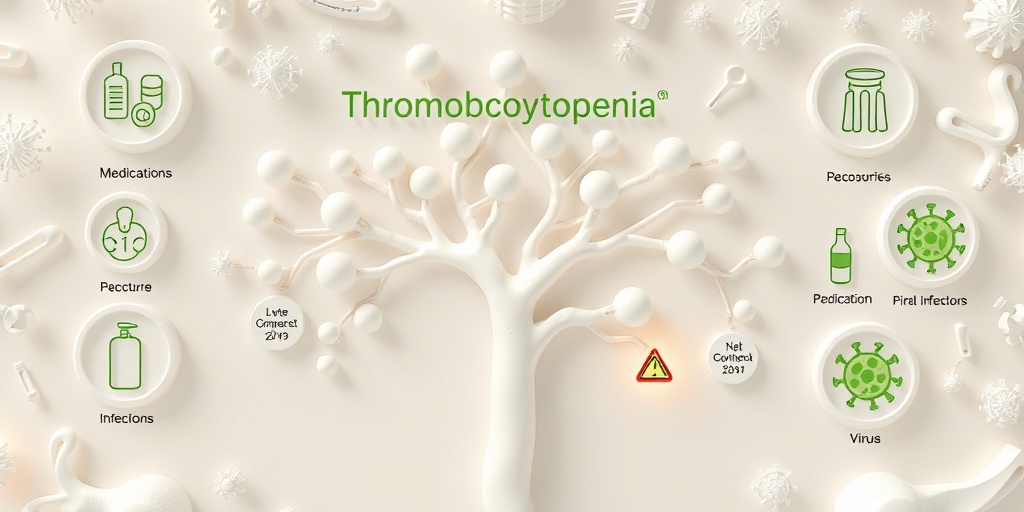What Is Thrombocytopenia?
Thrombocytopenia is a medical condition characterized by an abnormally low level of platelets in the blood. Platelets, or thrombocytes, are crucial for blood clotting and wound healing. When the platelet count drops below the normal range, which is typically between 150,000 and 450,000 platelets per microliter of blood, it can lead to various health complications.
This condition can arise from several underlying causes, including:
- Decreased Production: Conditions affecting the bone marrow, such as leukemia or aplastic anemia, can hinder the production of platelets.
- Increased Destruction: Certain autoimmune disorders, like immune thrombocytopenic purpura (ITP), can cause the body to mistakenly destroy its own platelets.
- Sequestration: An enlarged spleen can trap platelets, leading to a lower count in circulation.
- Medications: Some drugs, including certain antibiotics and chemotherapy agents, can also contribute to thrombocytopenia.
Understanding thrombocytopenia is essential, as it can manifest in various ways and may require different treatment approaches depending on the underlying cause. For those seeking more information on this condition, resources like Yesil Health AI provide evidence-based health answers that can help clarify any questions.
Thrombocytopenia Symptoms
The symptoms of thrombocytopenia can vary significantly based on the severity of the condition and its underlying cause. Some individuals may experience no symptoms at all, while others may notice several warning signs. Here are some common symptoms to watch for:
- Easy Bruising: Individuals with thrombocytopenia may notice that they bruise easily, even from minor bumps or injuries.
- Frequent Nosebleeds: A low platelet count can lead to spontaneous nosebleeds, which may occur without any apparent cause.
- Prolonged Bleeding: Cuts or injuries may take longer to stop bleeding than usual, which can be concerning.
- Blood in Urine or Stool: In some cases, thrombocytopenia can lead to blood appearing in urine or stool, indicating a more serious issue.
- Fatigue: Some individuals may experience fatigue or weakness, which can be attributed to the body’s struggle to manage low platelet levels.
In pregnant women, thrombocytopenia can manifest as gestational thrombocytopenia, which typically resolves after delivery. However, it’s essential for expectant mothers to monitor their platelet levels, as severe cases can lead to complications for both the mother and the baby.
If you or someone you know is experiencing these symptoms, it’s crucial to consult a healthcare professional for a proper diagnosis and treatment plan. Early intervention can help manage the condition effectively and prevent potential complications.
In summary, thrombocytopenia is a condition that warrants attention due to its potential impact on health. By recognizing the symptoms and understanding the underlying causes, individuals can take proactive steps toward managing their health. For more detailed information and personalized advice, consider visiting Yesil Health AI, where you can find reliable health resources tailored to your needs. 🌟

Causes of Thrombocytopenia
Thrombocytopenia, characterized by a low platelet count in the blood, can arise from various underlying conditions and factors. Understanding the causes is crucial for effective diagnosis and treatment. Here are some of the primary causes of thrombocytopenia:
1. Bone Marrow Disorders
The bone marrow is responsible for producing platelets. Any disorder affecting this vital organ can lead to thrombocytopenia. Conditions such as:
- Aplastic Anemia: A rare condition where the bone marrow fails to produce enough blood cells.
- Leukemia: A type of cancer that affects blood and bone marrow, leading to reduced platelet production.
- Myelodysplastic Syndromes: A group of disorders caused by poorly formed or dysfunctional blood cells.
2. Increased Destruction of Platelets
In some cases, the body may destroy platelets faster than they can be produced. This can occur due to:
- Immune Thrombocytopenic Purpura (ITP): An autoimmune disorder where the immune system mistakenly attacks and destroys platelets.
- Thrombotic Thrombocytopenic Purpura (TTP): A rare blood disorder that causes small blood clots to form throughout the body, leading to a decrease in platelet count.
- Heparin-Induced Thrombocytopenia (HIT): A reaction to heparin, a blood thinner, that causes a drop in platelet levels.
3. Sequestration of Platelets
The spleen plays a significant role in filtering blood and can sequester (trap) platelets. Conditions that can lead to an enlarged spleen (splenomegaly) include:
- Liver Disease: Conditions like cirrhosis can cause the spleen to enlarge, leading to increased platelet sequestration.
- Infections: Certain infections can also cause splenomegaly, contributing to thrombocytopenia.
4. Medications
Some medications can lead to thrombocytopenia as a side effect. Common culprits include:
- Antibiotics: Certain antibiotics can affect platelet production.
- Anticonvulsants: Medications used to treat seizures may also impact platelet levels.
- Chemotherapy Drugs: These can significantly reduce platelet production as they target rapidly dividing cells.
5. Infections
Various infections can lead to thrombocytopenia, either through direct effects on the bone marrow or by triggering an immune response. Notable infections include:
- Viral Infections: Viruses like HIV, hepatitis C, and dengue fever can cause a drop in platelet counts.
- Bacterial Infections: Severe bacterial infections can lead to disseminated intravascular coagulation (DIC), which consumes platelets.
Risk Factors for Thrombocytopenia
Identifying risk factors for thrombocytopenia can help in early detection and management. Here are some key risk factors to consider:
1. Age
Thrombocytopenia can occur at any age, but older adults are at a higher risk due to age-related changes in bone marrow function and increased likelihood of chronic diseases.
2. Medical History
Individuals with a history of certain medical conditions are more susceptible to thrombocytopenia. These include:
- Autoimmune Disorders: Conditions like lupus or rheumatoid arthritis can increase the risk.
- Blood Disorders: Previous diagnoses of blood disorders can predispose individuals to thrombocytopenia.
3. Medications
As mentioned earlier, certain medications can lead to thrombocytopenia. Individuals taking long-term medications, especially those affecting blood clotting, should be monitored closely.
4. Alcohol Consumption
Excessive alcohol intake can impair platelet production and function, increasing the risk of thrombocytopenia. Moderation is key! 🍷
5. Pregnancy
Pregnant women may experience a condition known as gestational thrombocytopenia, which typically resolves after delivery. However, monitoring is essential to ensure the health of both mother and baby.
6. Family History
A family history of blood disorders can increase the likelihood of developing thrombocytopenia. Genetic factors may play a role in the predisposition to certain conditions affecting platelet counts.
Understanding the causes and risk factors of thrombocytopenia is vital for effective management and treatment. If you or someone you know is experiencing symptoms related to low platelet counts, it’s essential to consult a healthcare professional for proper evaluation and care. 🩺

Diagnosing Thrombocytopenia
Thrombocytopenia, characterized by a low platelet count, can be a concerning condition that requires careful evaluation. Understanding how this condition is diagnosed is crucial for effective management and treatment. Here’s a closer look at the diagnostic process.
Understanding Platelet Counts
Platelets are small cell fragments in the blood that play a vital role in blood clotting. A normal platelet count ranges from 150,000 to 450,000 platelets per microliter of blood. When the count falls below 150,000, it is classified as thrombocytopenia. The severity of the condition can vary:
- Mild thrombocytopenia: 100,000 to 150,000 platelets
- Moderate thrombocytopenia: 50,000 to 100,000 platelets
- Severe thrombocytopenia: Less than 50,000 platelets
Initial Evaluation
The diagnostic process typically begins with a thorough medical history and physical examination. Your healthcare provider will ask about:
- Any symptoms you may be experiencing, such as bruising, bleeding, or fatigue
- Your medical history, including any previous health conditions or medications
- Family history of blood disorders
Blood Tests
To confirm a diagnosis of thrombocytopenia, several blood tests may be conducted:
- Complete Blood Count (CBC): This test measures the number of platelets, red blood cells, and white blood cells in your blood.
- Peripheral Blood Smear: A sample of your blood is examined under a microscope to assess the size and appearance of the platelets.
- Bone Marrow Biopsy: In some cases, a sample of bone marrow may be taken to determine if the marrow is producing enough platelets.
Identifying Underlying Causes
Diagnosing thrombocytopenia also involves identifying any underlying causes. Some common causes include:
- Autoimmune disorders: Conditions like lupus or idiopathic thrombocytopenic purpura (ITP) can lead to low platelet counts.
- Infections: Certain viral infections, such as HIV or hepatitis, can affect platelet production.
- Medications: Some medications, including certain antibiotics and chemotherapy drugs, can cause thrombocytopenia.
Once the diagnosis is confirmed and the underlying cause is identified, your healthcare provider can recommend appropriate treatment options.
Thrombocytopenia Treatment Options
Treating thrombocytopenia effectively depends on the underlying cause and the severity of the condition. Here are some common treatment options available:
Observation and Monitoring
In cases of mild thrombocytopenia, especially if there are no significant symptoms, your doctor may recommend a watchful waiting approach. Regular monitoring of platelet counts can help ensure that the condition does not worsen.
Medications
For more severe cases or when symptoms are present, various medications may be prescribed:
- Corticosteroids: These can help increase platelet counts by suppressing the immune system’s response that destroys platelets.
- Immunoglobulins: Intravenous immunoglobulin (IVIG) can be used to raise platelet counts quickly in certain situations.
- Thrombopoietin receptor agonists: These medications stimulate the bone marrow to produce more platelets.
Addressing Underlying Conditions
If thrombocytopenia is caused by an underlying condition, treating that condition is essential. For example:
- Infections: Treating the infection can help restore normal platelet levels.
- Autoimmune disorders: Managing the autoimmune condition may improve platelet counts.
Platelet Transfusions
In cases of severe thrombocytopenia, especially when there is a risk of bleeding, platelet transfusions may be necessary. This procedure involves infusing platelets from a donor to quickly increase the platelet count.
Surgery
In rare cases, if the spleen is responsible for the destruction of platelets, a surgical procedure called splenectomy may be recommended. Removing the spleen can help improve platelet counts in certain patients.
Understanding the treatment options for thrombocytopenia is crucial for effective management. Always consult with a healthcare professional to determine the best course of action tailored to your specific situation. 🩺

Living with Thrombocytopenia
Thrombocytopenia, a condition characterized by a low platelet count, can significantly impact daily life. Understanding how to manage this condition is crucial for maintaining a good quality of life. Here, we’ll explore practical tips and lifestyle adjustments that can help individuals living with thrombocytopenia.
Understanding Your Condition
First and foremost, it’s essential to have a clear understanding of thrombocytopenia. This condition can arise from various causes, including bone marrow disorders, autoimmune diseases, or certain medications. Knowing the underlying cause can help tailor your management plan.
Regular Monitoring
Regular blood tests are vital for monitoring platelet levels. Keeping track of your counts can help you and your healthcare provider make informed decisions about your treatment and lifestyle adjustments. It’s advisable to maintain a log of your platelet counts and any symptoms you experience.
Dietary Considerations
While there is no specific diet for thrombocytopenia, certain foods can support overall health and potentially improve platelet counts. Consider incorporating the following into your diet:
- Leafy Greens: Foods like spinach and kale are rich in vitamins and minerals.
- Fruits: Berries, oranges, and bananas provide essential nutrients.
- Lean Proteins: Chicken, fish, and legumes can help maintain overall health.
- Healthy Fats: Avocados and nuts are beneficial for heart health.
Staying hydrated is also crucial. Aim for at least 8 glasses of water a day to support your body’s functions. 💧
Managing Symptoms
Individuals with thrombocytopenia may experience symptoms such as easy bruising, prolonged bleeding, or fatigue. Here are some strategies to manage these symptoms:
- Protect Yourself: Use protective gear during activities that could lead to injury.
- Rest: Ensure you get adequate rest to combat fatigue.
- Communicate: Inform your healthcare provider about any new symptoms or concerns.
Emotional Well-being
Living with a chronic condition can take a toll on mental health. It’s important to prioritize your emotional well-being. Consider the following:
- Support Groups: Joining a support group can provide a sense of community and understanding.
- Therapy: Speaking with a mental health professional can help you cope with anxiety or depression.
- Mindfulness Practices: Techniques such as meditation or yoga can promote relaxation and reduce stress.
Thrombocytopenia Complications
While thrombocytopenia itself can be concerning, it’s essential to be aware of potential complications that may arise from this condition. Understanding these risks can help you take proactive steps to mitigate them.
Increased Bleeding Risk
One of the most significant complications of thrombocytopenia is an increased risk of bleeding. This can manifest in various ways, including:
- Easy Bruising: Individuals may notice bruises appearing with minimal or no trauma.
- Prolonged Bleeding: Cuts or injuries may take longer to stop bleeding.
- Internal Bleeding: In severe cases, internal bleeding can occur, leading to serious health issues.
It’s crucial to seek immediate medical attention if you experience unusual bleeding or bruising. 🚑
Impact on Daily Activities
Thrombocytopenia can affect your ability to engage in daily activities. Individuals may need to modify their routines to avoid situations that could lead to injury. This might include:
- Avoiding Contact Sports: High-risk activities should be limited to prevent injuries.
- Careful Planning: When traveling or participating in social events, consider your condition and plan accordingly.
Potential for Severe Complications
In rare cases, thrombocytopenia can lead to severe complications, such as:
- Thrombotic Thrombocytopenic Purpura (TTP): A rare blood disorder that can cause blood clots and low platelet counts.
- Hemolytic Uremic Syndrome (HUS): A condition that can lead to kidney failure.
Being aware of these potential complications can help you stay vigilant and seek timely medical intervention when necessary.
In conclusion, living with thrombocytopenia requires a proactive approach to health management. By understanding the condition, monitoring symptoms, and being aware of potential complications, individuals can lead fulfilling lives while managing their health effectively.

Frequently Asked Questions about Thrombocytopenia
What is Thrombocytopenia?
Thrombocytopenia is a medical condition characterized by a low platelet count in the blood. Platelets are essential for blood clotting, and a deficiency can lead to increased bleeding and bruising.
What are the common causes of Thrombocytopenia?
There are several potential causes of thrombocytopenia, including:
- Bone marrow disorders
- Autoimmune diseases
- Infections
- Medications that affect platelet production
- Pregnancy-related conditions
What are the symptoms of Thrombocytopenia?
Symptoms can vary but may include:
- Easy bruising
- Frequent nosebleeds
- Prolonged bleeding from cuts
- Blood in urine or stool
- Fatigue or weakness
How is Thrombocytopenia diagnosed?
Diagnosis typically involves blood tests to measure platelet levels and may include additional tests to determine the underlying cause.
What treatments are available for Thrombocytopenia?
Treatment options depend on the cause and severity of thrombocytopenia. They may include:
- Medications to boost platelet production
- Blood transfusions
- Addressing underlying conditions
- In severe cases, splenectomy (removal of the spleen)
Can Thrombocytopenia occur during pregnancy?
Yes, thrombocytopenia in pregnancy is known as gestational thrombocytopenia and is usually mild. However, it is essential to monitor it closely to prevent complications.
Is Thrombocytopenia common in dogs?
Thrombocytopenia in dogs can occur and may be caused by various factors, including infections, immune disorders, or bone marrow issues. If you notice unusual bleeding or bruising in your pet, consult a veterinarian.
How can I raise my platelet count?
To raise platelet counts, it is crucial to address the underlying cause. Some general recommendations include:
- Eating a balanced diet rich in vitamins and minerals
- Avoiding alcohol and certain medications that can lower platelet counts
- Consulting with a healthcare provider for personalized advice
Where can I find more information about Thrombocytopenia?
For more detailed information, consider consulting medical resources or speaking with a healthcare professional. Online forums and support groups can also provide valuable insights and shared experiences. 😊




